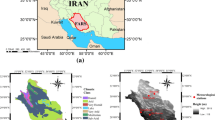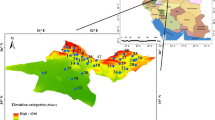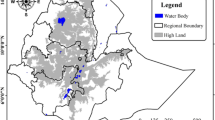Abstract
Agriculture is the most sensitive sector which has largely been affected by the impacts of drought. The study aims to detect and characterize agricultural droughts using MODIS-based multiple indices in North Wollo, Ethiopia. Two Moderate Resolution Imaging Spectroradiometer (MODIS) datasets (MOD13Q1 and MOD11A2) for the period 2000 to 2019 were used to generate Normalized Difference Vegetation Index (NDVI) and Land Surface Temperature (LST). Accordingly, NDVI anomaly, Vegetation Condition Index (VCI), Temperature Condition Index (TCI), and Vegetation Health Index (VHI) were computed to characterize agricultural droughts during the crop growing season. Both the NDVI anomaly and VCI confirmed that there was no single drought-free year in the area throughout the study period. TCI showed relatively exaggerated drought stress than the other indices. However, VHI indicated lower area coverage and a lower level of stress than its aggregates (VCI and TCI). Specifically, 2002, 2004, 2009, 2010, and 2015 were all identified as severe drought years, where over 60% of the area was affected by droughts. Results of the regression analysis indicated that VCI, TCI, and VHI were having significant positive trends with precipitation in the majority of the districts. Using the aggregated drought frequency of each index, 13.5, 73.7, and 12.8% of the area were under moderate, high, and extremely high levels of agricultural drought occurrence, respectively, and the likelihood of implied risks. Therefore, all the districts of North Wollo were affected by persistent drought stress. Such drought recurrences have the potential to impose significant impacts on the agro-based livelihoods of the local community demanding ongoing drought monitoring and the application of effective early warning systems.









Similar content being viewed by others
Data availability
The datasets used during the current study are freely available on websites listed in the acknowledgment.
References
Adhikari, U., Nejadhashemi, A. P., & Woznicki, S. A. (2015). Climate change and eastern Africa: A review of impact on major crops. Food and Energy Security, 4(2), 110–132. https://doi.org/10.1002/fes3.61
Anyamba, A., & Tucker, C. J. (2012). Historical perspectives on AVHRR NDVI and vegetation drought monitoring. NASA Publications, 217.
Aragie, T., & Genanu, S. (2017). Level and determinants of food security in North Wollo Zone (Amhara Region – Ethiopia). 5(6), 232–247. https://doi.org/10.12691/jfs-5-6-4
Asfaw, A., Bantider, A., Simane, B., & Hassen, A. (2021). Smallholder farmers’ livelihood vulnerability to climate change-induced hazards: Agroecology-based comparative analysis in Northcentral Ethiopia (Woleka Sub-basin). Heliyon, 7(4), e06761. https://doi.org/10.1016/j.heliyon.2021.e06761
Azadi, H., Keramati, P., Taheri, F., Rafiaani, P., Teklemariam, D., Gebrehiwotg, G., Hosseininiah, H., Passelb, S., & Lebaillyi, P. (2018). Agricultural land conversion: Reviewing drought impacts and coping strategies. International Journal of Disaster Risk Reduction, 31(2018), 184–195. https://doi.org/10.1016/j.ijdrr.2018.05.003
Bayissa, Y., Tadesse, T., Svoboda, M., Wardlow, B., Swigart, J., & Andel, S. (2018). Developing a satellite-based combined drought indicator to monitor agricultural drought: A case study for Ethiopia. Giscience & Remote Sensing, 00(00), 1–31. https://doi.org/10.1080/15481603.2018.1552508
Belayneh, A., Adamowski, J., Khalil, B., & Ozga-zielinski, B. (2014). Long-term SPI drought forecasting in the Awash River Basin in Ethiopia using wavelet neural network and wavelet support vector regression models. Journal of Hydrology, 508, 418–429. https://doi.org/10.1016/j.jhydrol.2013.10.052
Bento, V., Trigo, I., Gouveia, C., & DaCamara, C. (2018). Contribution of land surface temperature (TCI) to vegetation health index: A comparative study using clear sky and all-weather climate data records. Remote Sensing, 10(1324). https://doi.org/10.3390/rs10091324
Bentoa, V. A., Gouveiaa, C. M., DaCamaraa, C. C., & Trigoa, I. F. (2018). A climatological assessment of drought impact on vegetation health index. Agricultural and Forest Meteorology, 259, 286–295. https://doi.org/10.1016/j.agrformet.2018.05.014
Byakatonda, J., Parida, B., & Kenabatho, P. (2018). Relating the dynamics of climatological and hydrological droughts in semiarid Botswana. Physics and Chemistry of the Earth, 105, 12–24. https://doi.org/10.1016/j.pce.2018.02.004
Cai, G., Du, M., & Liu, Y. (2011). Regional drought monitoring and analyzing using MODIS data—a case study in Yunnan province. In and Y. C. D. Li, Y. Liu (Ed.), CCTA 2010, Part II (Internatio, Issue 1, pp. 243–251).
Cai, G., Du, M., & Liu, Y. (2017). Regional drought monitoring and analyzing using MODIS data—A case study in Yunnan province. In 4th Conference on Computer and Computing Technologies in Agriculture (CCTA).
CSA. (2013). Population projection of Ethiopia for all regions from 2014 – 2017 (Issue August 2013). CSA.
Dai, A. (2011). Drought under global warming: Advanced review. Climate Change, 2011(2), 45–65. https://doi.org/10.1002/wcc.81
Demisse, G. B., Tadesse, T., Bayissa, Y., Atnafu, S., Argaw, M., & Nedaw, D. (2018). Vegetation condition prediction for drought monitoring in pastoralist areas: A case study in Ethiopia. International Journal of Remote Sensing, 1–17. https://doi.org/10.1080/01431161.2017.1421797
Desportes, I. (2016). Responding to the 2016 drought amid political protest and a state of emergency in Ethiopia (Vol. 4).
Didan, K., Munoz, A. B., & Huete, A. (2015). MODIS Vegetation Index User’s Guide (MOD13 Series). Vegetation Index and Phenology Lab, the University of Arizona.
Dinku, T., Funk, C., Peterson, P., Maidment, R., Tadesse, T., Gadain, H., & Ceccato, P. (2018). Validation of the CHIRPS satellite rainfall estimates over eastern Africa. Advances in Remote Sensing Of Rainfall and Snowfall, January, 292–312. https://doi.org/10.1002/qj.3244
Dogan, S., Berktay, A., & Singh, V. P. (2012). Comparison of multi-monthly rainfall-based drought severity indices, with application to semi-arid Konya closed basin, Turkey. Journal of Hydrology, 470–471, 255–268. https://doi.org/10.1016/j.jhydrol.2012.09.003
Du, L., Tian, Q., Yu, T., Meng, Q., Jancso, T., Udvardy, P., & Huang, Y. (2013). A comprehensive drought monitoring method integrating MODIS and TRMM data. International Journal of Applied Earth Observations and Geoinformation, 23, 245–253. https://doi.org/10.1016/j.jag.2012.09.010
Evans, J. D. (1996). Straight forward statistics for the behavioral sciences. Brooks/Cole, Pacifc Grove.
Frey, C. M., Kuenzer, C., & Dech, S. (2012). Quantitative comparison of the operational NOAA-AVHRR LST product of DLR and the MODIS LST product V005. International Journal of Remote, 33(22), 37–41. https://doi.org/10.1080/01431161.2012.699693
Funk, C., Peterson, P., Landsfeld, M., Pedreros, D., Verdin, J., Shukla, S., Husak, G., Rowland, J., Harrison, L., Hoell, A., & Michaelsen, J. (2015). The climate hazards infrared precipitation with stations—A new environmental record for monitoring extremes. Scientific Data, 1–21. https://doi.org/10.1038/sdata.2015.66
Gaikwad, S., Kale, K., Kulkarni, S., Varpe, A. B., & Pathare, G. (2015). Agricultural drought severity assessment using remotely sensed data: A review. International Journal of Advanced Remote Sensing and GIS, 4(1), 1195–1203.
Gao, F., Morisette, J. T., Wolfe, R. E., Ederer, G., Pedelty, J., Masuoka, E., Myneni, R., Tan, B., & Nightingale, J. (2008). An Algorithm to Produce Temporally and Spatially Continuous MODIS-LAI Time Series, 5(1), 60–64.
Gebre, E., Berhan, G., & Lelago, A. (2017). Application of remote sensing and GIS to characterize agricultural drought conditions in North Wollo Zone, Amhara Regional State, Ethiopia. Journal of Natural Sciences Research, 7(17).
Gebrechorkos, S., Hülsmann, S., & Bernhofer, C. (2018). Evaluation of multiple climate data sources for managing environmental resources in East Africa. Hydrology and Earth System Science, 22, 4547–4564.
Gebrehiwot, T., Van der Veen, A., & Maathuis, B. (2016). Governing agricultural drought: Monitoring using the vegetation condition index. Ethiopian Journal of Environmental Studies and Management, 9(3), 354. https://doi.org/10.4314/ejesm.v9i3.9
Ghaleb, F., Mario, M., & Sandra, A. (2015). Regional Landsat-based drought monitoring from 1982 to 2014. Climate, 3, 563–577. https://doi.org/10.3390/cli3030563
Gidey, E., Dikinya, O., Sebego, R., Segosebe, E., & Zenebe, A. (2018a). Analysis of the long‑term agricultural drought onset, cessation, duration, frequency, severity and spatial extent using vegetation health index (VHI) in Raya and its environs, Northern Ethiopia. Environmental Systems Research, 7(13). https://doi.org/10.1186/s40068-018-0115-z
Gidey, E., Dikinya, O., Sebego, R., Segosebe, E., & Zenebe, A. (2018b). Using drought indices to model the statistical relationships between meteorological and agricultural drought in Raya and its environs, Northern Ethiopia. Earth Systems and Environment. https://doi.org/10.1007/s41748-018-0055-9
Gonfa, L. (1996). Climate classification of Ethiopia (No. 3; Meteorological Research Report Series., pp. 1–76). National Meteorological Service Agency (NMA).
Guo, H., Bao, A., Liu, T., Jiapaer, G., Ndayisaba, F., & Jiang, L. (2018). Spatial and temporal characteristics of droughts in Central Asia. Science of the Total Environment, 624, 1523–1538. https://doi.org/10.1016/j.scitotenv.2017.12.120
Hailu, S. (2013). The impact of disaster risk management interventions in humanitarian programmes on household food security: The case of East africa, Ethiopia, Amhara Region, North Wollo Zone.
Hao, Z., Singh, V. P., & Xia, Y. (2018). Seasonal drought prediction: Advances, challenges, and future prospects. Reviews of Geophysics, 56(1), 108–141. https://doi.org/10.1002/2016RG000549
HRD. (2016). Joint Government and Humanitarian Partners’ Document: 2016 Humanitarian Requirement Document, Ethiopia (Humanitarian Requirement Document, Ethiopia No. 2016; Humanitarian Requirement Document, Ethiopia).
HRD. (2017). Joint Government and Humanitarian Partners’ Document: 2017 Humanitarian Requirements Documen, Ethiopia (2016 Humanitarian Requirement Document, Ethiopia).
IPCC. (2014). Synthesis Report. Contribution of Working Groups I, II and III to the Fifth Assessment Report of the Intergovernmental Panel on Climate Change.
Karnieli, A., Agam, N., Pinker, R. T., Anderson, M., Imhoff, M. L., Gutman, G. G., Panov, N., & Goldberg, A. (2010). Use of NDVI and land surface temperature for drought assessment: Merits and limitations. Journal of Climate, 23(3), 618–633. https://doi.org/10.1175/2009JCLI2900.1
Kiem, A., Johnson, F., Westra, S., Dijk, A., Evans, J., Donnell, A., Rouillard, A., Barr, C., Tyler, J., Thyer, M., Jakob, D., Woldemeskel, F., Sivakumar, B., & Mehrotra, R. (2016). Natural hazards in Australia: Droughts. Climatic Change. https://doi.org/10.1007/s10584-016-1798-7
Kogan, F. (1995). Application of vegetation index and brightness temperature for drought detection. Advances in Space Research, 15(11), 91–100. https://doi.org/10.1016/0273-1177(95)00079-T
Kogan, F. (1997). Global drought watch from space. American Meteorological Society, 621–636.
Kogan, F., Guo, W., & Yang, W. (2019). Drought and food security prediction from NOAA new generation of operational satellites. Geomatics, Natural Hazards and Risk, 10(1), 651–666. https://doi.org/10.1080/19475705.2018.1541257
Kundu, A., Dwivedi, S., & Dutta, D. (2016). Monitoring the vegetation health over India during contrasting monsoon years using satellite remote sensing indices. The Arabian Journal of Geosciences, 9(144). https://doi.org/10.1007/s12517-015-2185-9
Legesse, G., & Suryabhagavan, K. V. (2014). Remote sensing and GIS based agricultural drought assessment in East Shewa Zone Ethiooia. Tropical Ecology, 55(3), 349–363.
Liou, Y., & Mulualem, G. M. (2019). Spatio – temporal assessment of drought in Ethiopia and the impact of recent intense droughts. Remote Sensing, 11, 1–19. https://doi.org/10.3390/rs11151828
Little, P. D., Stone, M. P., Mogues, T., Castro, A. P., & Negatu, W. (2006). ‘Moving in place’: Drought and poverty dynamics in South Wollo Ethiopia. Journal of Development Studies, 42(2), 200–225. https://doi.org/10.1080/00220380500405287
Lyon, B. (2014). Seasonal drought in the Greater Horn of Africa and its recent increase during the March-May Long Rains. Journal of Climate, 27, 7953–7975. https://doi.org/10.1175/JCLI-D-13-00459.1
Martinez, P., & Blanco, M. (2019). Sensitivity of agricultural development to water-related drivers: The case of Andalusia (Spain). Water, 11(9), 1–21. https://doi.org/10.3390/w11091854
Matewos, T. (2019). Climate change-induced impacts on smallholder farmers in selected districts of Sidama, Southern Ethiopia. Climate, 7(70), 1–17. https://doi.org/10.3390/cli7050070
Measho, S., Chen, B., Trisurat, Y., Pellikka, P., Guo, L., Arunyawat, S., Tuankrua, V., Ogbazghi, W., & Yemane, T. (2019). Spatio-temporal analysis of vegetation dynamics as a response to climate variability and drought patterns in the Semiarid Region, Eritrea. Remote Sensing, 11(6). https://doi.org/10.3390/RS11060724
Mekonen, A. A., & Berlie, A. B. (2021). Rural households’ livelihood vulnerability to climate variability and extremes: A livelihood zone-based approach in the Northeastern Highlands of Ethiopia. Ecological Processes, 10(1), 55. https://doi.org/10.1186/s13717-021-00313-5
Mekonen, A. A., Berlie, A. B., & Ferede, M. B. (2020). Spatial and temporal drought incidence analysis in the northeastern highlands of Ethiopia. Geoenvironmental Disasters, 7(10). https://doi.org/10.1186/s40677-020-0146-4
Mera, G. A. (2018). Drought and its impacts in Ethiopia. Weather and Climate Extremes, 22, 24–35. https://doi.org/10.1016/j.wace.2018.10.002
Meze-Hausken, E. (2000). Migration caused by climate change: How vulnerable are people in dryland areas: A case-study in Northern Ethiopia. Mitigation and Adaptation Strategies for Global Chang, 5, 379–406.
Mishra, A. K., & Singh, V. P. (2010). A review of drought concepts. Journal of Hydrology, 391(1–2), 202–216. https://doi.org/10.1016/j.jhydrol.2010.07.012
Mohammed, Y., Yimer, F., Tadesse, M., & Tesfaye, K. (2017). Meteorological drought assessment in north east highlands of Ethiopia. International Journal of Climate Change Strategies and Management, 1–201. https://doi.org/10.1108/IJCCSM-12-2016-0179
Mohammed, Y., Yimer, F., Tadesse, M., & Tesfaye, K. (2018). Meteorological drought assessment in north east highlands of Ethiopia. International Journal of Climate Change Strategies and Management, 10(1), 142–160. https://doi.org/10.1108/IJCCSM-12-2016-0179
Morid, S., Smakhtin, V., & Moghaddasi, M. (2006). Comparison of seven meteorological indices for drought monitoring in Iran. International Journal of Climatology, 26(7), 971–985. https://doi.org/10.1002/joc.1264
Mpelasoka, F., Awange, J. L., & Zerihun, A. (2018). Influence of coupled ocean-atmosphere phenomena on the Greater Horn of Africa droughts and their implications. Science of the Total Environment, 610–611, 691–702. https://doi.org/10.1016/j.scitotenv.2017.08.109
Munira, S., Alves, M., & Marin, M. (2018). Evaluating Precipitation estimates from Eta, TRMM and CHRIPS data in the south-southeast region of Minas Gerais site—Brazil. Remote Sensing Article, 10. https://doi.org/10.3390/rs10020313
Mutsotso, R. B., Sichangi, A. W., & Makokha, G. O. (2018). Spatio-temporal drought characterization in Kenya from 1987 to 2016. Advances in Remote Sensing, 07(02), 125–143. https://doi.org/10.4236/ars.2018.72009
Nanzad, L., Zhang, J., Tuvdendorj, B., Nabil, M., Zhanga, S., & Baia, Y. (2019). NDVI anomaly for drought monitoring and its correlation with climate factors over Mongolia from 2000 to 2016. Journal of Arid Environments. https://doi.org/10.1016/j.jaridenv.2019.01.019
Pathak, A., & Dodamani, B. M. (2016). Comparison of two hydrological drought indices. Perspectives in Science, 8, 626–628. https://doi.org/10.1016/j.pisc.2016.06.039
Paulo, A. A., & Pereira, L. S. (2006). Drought concepts and characterization: Comparing drought indices applied at local and regional scales. Water International, 31(1), 37–41. https://doi.org/10.1080/02508060608691913
Senamaw, A., Addisu, S., & Suryabhagavan, K. V. (2021). Mapping the spatial and temporal variation of agricultural and meteorological drought using geospatial techniques, Ethiopia. Environmental Systems Research, 10(15). https://doi.org/10.1186/s40068-020-00204-2
Sholihah, R. I., Trisasongko, B. H., Shiddiq, D., Ode, L., & Iman, S. (2016). Identification of agricultural drought extent based on vegetation health indices of Landsat data: Case of Subang and Karawang, Indonesia. Nvironmental Sciences, 33, 14–20. https://doi.org/10.1016/j.proenv.2016.03.051
Sruthi, S., & Aslam, M. A. M. (2015). Agricultural drought analysis using the NDVI and land surface temperature data; a case study of Raichur district. Aquatic Procedia, 4, 1258–1264. https://doi.org/10.1016/j.aqpro.2015.02.164
Tadesse, N., Nedaw, D., Woldearegay, K., Gebreyohannes, T., & Steenbergen, F. V. (2015). Groundwater management for irrigation in the Raya and Kobo Valleys, Northern Ethiopia. International Journal of Earth Sciences and Engineering, 08(03), 36–46.
Trnka, M., Hayes, M., Jurečka, F., Bartošová, L., Anderson, M., Brown, J., Camarero, J. J., Cudlín, P., Dobrovolný, P., & Eitzinger, J. (2018). Priority questions in multidisciplinary drought research. Climate Research. https://doi.org/10.3354/cr01509
UNDRR. (2021). Special report on drought 2021: Global Assessment Report on Disaster Risk Reduction. United Nations Office for Disaster Risk Reduction (UNDRR), Geneva.
UNISDR. (2009). Drought risk reduction framework and practices: Contributing to the implementation of the Hyogo Framework for Action. United Nations secretariat of the International Strategy for Disaster Reduction (UNISDR), Geneva, Switzerland.
Viste, E., Korecha, D., & Sorteberg, A. (2013). Recent drought and precipitation tendencies in Ethiopia. Theoretical and Applied Climatology, 112(3–4), 535–551. https://doi.org/10.1007/s00704-012-0746-3
Wagesho, N., Goel, N. K., & Jain, M. K. (2013). Temporal and spatial variability of annual and seasonal rainfall over Ethiopia. Hydrological Sciences Journal ISSN: 6667. https://doi.org/10.1080/02626667.2012.754543
Wilhite, D., Sivakumar, M., & Pulwarty, R. (2014). Managing drought risk in a changing climate: The role of national drought policy. Weather and Climate Extremes, 3, 4–13. https://doi.org/10.1016/j.wace.2014.01.002
WMO, & GWP. (2016). Handbook of drought indicators and indices (M. Svoboda & B. Fuchs, Eds.; Drought Mi). DigitalCommons@University of Nebraska - Lincoln.
Wu, D., Qu, J., & Hao, X. (2015). Agricultural drought monitoring using MODIS-based drought indices over the USA Corn Belt. International Journal of Remote Sensing, 36(21), 5403–5425. https://doi.org/10.1080/01431161.2015.1093190
Zhang, J., Mu, Q., & Huang, J. (2016). Assessing the remotely sensed Drought Severity Index for agricultural drought monitoring and impact analysis in North China. Ecological Indicators, 63, 296–309. https://doi.org/10.1016/j.ecolind.2015.11.062
Zhang, X., Chen, N., Li, J., Chen, Z., & Niyogi, D. (2017). Multi-sensor integrated framework and index for agricultural drought monitoring. Remote Sensing of Environment, 188, 141–163. https://doi.org/10.1016/j.rse.2016.10.045
Acknowledgements
We would like to thank the USGS earth explorer for freely downloading different MODIS images of the study watershed from http://earthexplorer.usgs.gov. We also acknowledge the US Geological Survey (USGS) and the Climate Hazards Group at the University of California for developing the CHIRPS rainfall estimate and allowing us to freely download it at https://data.chc.ucsb.edu/products/CHIRPS-2.0/africa_monthly/. We are grateful to the Ethiopian National Meteorological Service Agency for providing the time series daily rainfall and temperature data of the study area.
Author information
Authors and Affiliations
Contributions
The first author collect data, analyzes it, and wrote the manuscript. The co-authors gave technical support and conceptual advice with comments for improvement. All authors discussed the contents, methods, and results of the manuscript. They also read, edited, and approved it.
Corresponding author
Ethics declarations
Conflict of interest
The authors declare no competing interests.
Additional information
Publisher's Note
Springer Nature remains neutral with regard to jurisdictional claims in published maps and institutional affiliations.
Rights and permissions
Springer Nature or its licensor holds exclusive rights to this article under a publishing agreement with the author(s) or other rightsholder(s); author self-archiving of the accepted manuscript version of this article is solely governed by the terms of such publishing agreement and applicable law.
About this article
Cite this article
Wassie, S.B., Mengistu, D.A. & Birlie, A.B. Agricultural drought assessment and monitoring using MODIS-based multiple indices: the case of North Wollo, Ethiopia. Environ Monit Assess 194, 787 (2022). https://doi.org/10.1007/s10661-022-10455-4
Received:
Accepted:
Published:
DOI: https://doi.org/10.1007/s10661-022-10455-4




